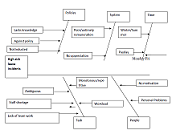Prevalence and Associated Factors for Sick Leave Among Bulawayo City Health Employees, Zimbabwe, 2013

Abstract:
Sick leave is time spent
away from work due to illness or injury. A preliminary review of sick leave records
for 2012 for the 6 clinics in Nkulumane showed 3 clinics experienced higher sick
leave incidents than the other 3 clinics. The study sought to establish the prevalence
and associated factors for sick leave in the City of Bulawayo, Zimbabwe. An analytic cross-sectional study was carried
out among Bulawayo City Health employees working in 20 health facilities. A total
of 144 respondents and 3 key informants were interviewed. An interviewer-administered
questionnaire, key informant interview guide, and a checklist were used to collect
data, which was analysed using Epi Info.
The prevalence of sick leave was 34%. Employees who took sick leave less than
six months ago were 4.3 times more likely to go on frequent sick leave than those
who did not (POR 4.3, P-Value 0.002). Employees who reported good team climate were
less likely to go on frequent sick leave (POR 0.29, P-Value 0.002). Feeling unappreciated
at work was a risk factor for frequent sick leave (POR 2.61, P-Value 0.01). The
cost of sick leave for the City of Bulawayo in 2012 was $US20 840. Periodic refresher meetings on conditions
of service, training of managers and other employees on good teamwork, and production
of a standard template for recording sick leave by clinics may assist in curbing
frequent sick leave incidents.
References:
[1] The Collins Online Dictionary: www.google.com
accessed 17/07/2013.
[2] Coggon D;
Ntani G; Vargas-Prada S; Martinez J.M; Serra C and Bernavides F.G, 2013, International Variation in Absence from Work
Attributed to Musculoskeletal Illness: Findings from the CUPID Study: Occupational and Environmental Medical
Journal, 70(8): 575-584
https://www.ncbi.nlm.nih.gov/pmc/articles/PMC3710073/.
[3] Brulin,
C., Goine, H., Edlund, C. 1998, Prevalence of Long-Term Sick Leave Among Female
Home Care Personnel in Northern Sweden. J Occup Rehabil 8, 103–111.
https://doi.org/10.1023/A:1023063506148
https://link.springer.com/article/10.1023/A:1023063506148#citeas.
[4] Henrekson
M and Mats Persson. 2004, The Effects on Sick Leave of Changes in the Sickness
Insurance System. Journal of Labor Economics, 22 (8) 87–113. www.jstor.org/stable/10.1086/380404.
[5] Smith M;
Sick Leave Abuse, A Chronic Workplace Ill?
http://humanresources.about.com/od/laborrelations/a/sickleaveabuse.htm.
[6] Mindtools:
Reducing Sick Leave: https://www.mindtools.com/pages/article/newTMM_56.htm.
[7] Law and
Justice Zimbabwe: Labour Act of Zimbabwe:
http://www.mywage.org/zimbabwe/main/decent-work-check/work-and-illness/sick-leave.
[8]
Donders
N.C.G.M; Bos J.T; Van der Velden K and Van der Gulden J, 2012, Age Differences in the Associations between Sick
Leave and Aspects of Health, Psychosocial Workload and Family Life, A Cross Sectional
Study: BMJ Open: 2 (4), http://europepmc.org/article/PMC/4400637.
[9] Priya C,
2020: Ishikawa (Fishbone or Cause and Effect) Diagram:
http://learnersdestination.com/ishikawa-fishbone-or-cause-and-effect-diagram/.
[10] Dørheim
SK, Bjorvatn B, Eberhard-Gran M, 2013. Sick leave during pregnancy: a longitudinal
study of rates and risk factors in a Norwegian population. BJOG.120(5):521-30.
doi: 10.1111/1471-0528.12035. Epub 2012 Nov 7. PMID: 23130975. https://pubmed.ncbi.nlm.nih.gov/23130975/.
[11] Backhausen
M, Damm P, Bendix J, Tabor A, Hegaard H, 2017, The prevalence of sick leave:
Reasons and associated predictors – A survey among employed pregnant women.
Sexual & Reproductive Healthcare.10.1016/j.srhc.2017.11.005. https://www.researchgate.net/publication/321238369_The_prevalence_of_sick_leave_Reasons_and_associated_predictors__A_survey_among_employed_pregnant_women.
[12] Rasmussen
OB, Sørensen AU, Nielsen CV, 1996, Sick leave for pregnant women in the
municipality of Fjend 1987-1990 Ugeskrift for Laeger.158(49):7069-7073. PMID:
8999614. https://europepmc.org/article/med/8999614.
[13] Holmgren,
K., Dahlin-Ivanoff, S., Björkelund, C, 2009, The prevalence of work-related
stress, and its association with self-perceived health and sick-leave, in a
population of employed Swedish women. BMC Public Health 9, 73. https://doi.org/10.1186/1471-2458-9-73
https://bmcpublichealth.biomedcentral.com/articles/10.1186/1471-2458-9-73#citeas.
[14] Fahlén,
G., Goine, H., Edlund, C, 2009, Effort-reward imbalance, “locked in” at work,
and long-term sick leave. Int Arch Occup Environ Health 82, 191–197. https://doi.org/10.1007/s00420-008-0321-5
https://link.springer.com/article/10.1007/s00420-008-0321-5#citeas.
[15] Isacsson
A, Hanson BS, Janzon L, Kugelberg G, 1992, The epidemiology of sick leave in an
urban population in Malmö, Sweden. Scandinavian Journal of Social Medicine
;20(4):234-239. doi:10.1177/140349489202000408 https://journals.sagepub.com/doi/abs/10.1177/140349489202000408.
[16] Roelen C.A;
Koopmans P.C; Schreuder J.A; Anema J.R and Van Der Beek A.J, 2011: The history of registered sickness absence predicts
future sickness absence, Journal of Occupational Medicine:
61(2):96-101 https://pubmed.ncbi.nlm.nih.gov/21173042/.
[17] Jacob
L, Koyanagi A, Smith L, Tanislav C, Konrad M, van der Beck S, Kostev K, 2021,
Prevalence of, and factors associated with, long-term COVID-19 sick leave in
working-age patients followed in general practices in Germany. Int J Infect
Dis. 2021 Jul 2; 109:203-208. doi: 10.1016/j.ijid.2021.06.063. Epub ahead of
print. PMID:34224870. https://pubmed.ncbi.nlm.nih.gov/34224870/.
[18]
Hultin
H; Lindholm C; Malfert M and Moller J, 2012:
Short Term Sick Leave and Future Rate
of Sickness Absence and Unemployment: The Impact of Health Status: BMC
Public Health: 12(861) https://bmcpublichealth.biomedcentral.com/articles/10.1186/1471-2458-12-861#citeas.
[19]
Hinnka
K; Kuoppala J; Vaananen-Tomppo I and Lamminpaa A, 2013: Psychosocial work factors and sick leave, occupational accident, and disability
pension; a cohort study of civil servants: Journal of Occupational and
Environmental Medicine:55(2):191-7 https://pubmed.ncbi.nlm.nih.gov/23364212/.
[20] Stapelfeldt, C.M., Jensen, C., Andersen, N.T, 2012, Validation of sick leave measures: self-reported sick leave and sickness benefit data from a Danish national register compared to multiple workplace-registered sick leave spells in a Danish municipality. BMC Public Health 12, 661. https://doi.org/10.1186/1471-2458-12-661 (Self https://link.springer.com/article/10.1186/1471-2458-12-661#citeas.
[21] Van
Poppel MN, de Vet HC, Koes BW, Smid T, Bouter LM, 2002, Measuring sick leave: a
comparison of self-reported data on sick leave and data from company records.
Occup Med (Lond);52(8):485-90. doi: 10.1093/occmed/52.8.485. PMID:12488520. https://pubmed.ncbi.nlm.nih.gov/12488520/.

